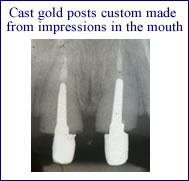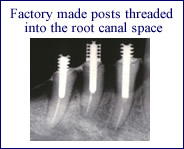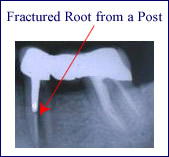Root canal therapy can be an important part of the restorative process. There are several reasons to perform root canal therapy prior to restoring teeth:
- Inflammation or infection of the nerve tissue
- Alteration of Tooth Position:
- Reduction of Overjet
- Reduction of Overbite
- Correction of Deformities
- Reduction of leverage forces on the bone and roots
- Creation of Maximum Esthetics
- Prevention of future trouble
This patient was born with missing lateral incisors. The canines are in the position where the lateral incisors are supposed to be. The patient felt that his teeth looked like fangs. Root canal therapy, custom-designed posts and porcelain crowns allowed his canine teeth to be transformed into lateral incisors. The result is a normal appearance.
When the pulp (nerve tissue) is in a tooth, the preparation of the tooth must take place around it. Sometimes the nerve is in the way of creating the ideal restoration. Once root canal therapy has been performed, there is complete control of the shape, size and inclination of the tooth. The teeth can be made smaller to reduce the forces on the bone and roots and brought into ideal alignment within the arch. In order to accomplish these feats, much of the tooth structure of above the gum has to be removed because it is in the wrong position.
A Post is a pin that fits into a root canal space in order to extend the length of a tooth above the gum. Posts help restore teeth that have been treated with root canal therapy. A root canal treated tooth with a post has the shape and form of an ideal tooth preparation for a crown. Posts help create a blue-print for the permanent restorations, enhance the retention of temporaries and facilitate impression-taking.
There are two types of posts:
- Custom-made (Cast) Post and Core A custom made post is created directly in the mouth or indirectly on a model with acrylic, wax or composite resin. This material is then cast into metal (usually gold). Some custom-made posts are not cast, but milled instead by machine from a block of ceramic material. The core is that part of the post above the gumline. Custom made posts allow the dentist to change the inclination teeth. Teeth that are flared out are often brought back into ideal position with endodontics and posts. Changing the inclination of the cores is like instant orthodontics!
- Prefabricated Post and Core Build-up. Prefabricated posts come in different sizes designed to fit canals that are prepared with special drills. The posts are then cemented or threaded into place. Composite resin or acrylic is then added to the part of the post above the gum line to form a core build-up. Prefabricated posts are usually confined to the direction of the long axis of the tooth.
Unfortunately, posts have two major disadvantages:
- Retention.
The ability of posts to retain crown and bridgework is questionable. Most dentists depend on posts for retention and often perform root canal treatment just to place a post for retention of a crown. However, examination of crown and bridgework successes and failures for the last fifty years reveals that real retention of crowns comes from getting a good grip on the root surface, not from the post. When crowns and bridges fail, the posts almost always are dislodged with the restoration. This is true for all types of posts and cementing/bonding media However, the combination of a shoulder (a circumferential flat ledge) and long apron (root surface under the gum) can provide more than enough retention for a crown without the need for a post. Thousands of teeth flush with the gum have been treated successfully in this manner. There really is no difference between teeth that are flush with the gum and teeth with a lot of tooth structure above the gum. The fit of the crown under the gum is more important for its retention in the mouth than the type of cement or bonding that is used. Copper band impressions make it possible to take advantage of all f the root surface below the gum. The rubber impressions with retraction cord advocated by most dentists usually can’t register a complete impression of the root surface. Our patients wear crowns on teeth flush with gum without posts with Vaseline ointment or rubber and they don’t fall out! We want to make sure everything is perfect before permanent cementation.
- Fracture.
Root canal teeth generally become brittle because the ability to hydrate teeth from the inside is lost when the pulp tissue is removed As a result, root canal teeth are much more prone to fracture than vital teeth with nerves. Contrary to popular opinion, posts do not make the teeth stronger—they make them weaker. Posts apply stresses that can make root canal teeth more likely to fracture—especially if the teeth are multi-rooted and have curves, such as molars and bicuspids. Once a root has fractured from a post, it is usually lost. As a result, the use of posts in multi-rooted posterior (back) teeth is not recommended. Posts should only be used in teeth with large, single-rooted canals (usually front teeth only)






